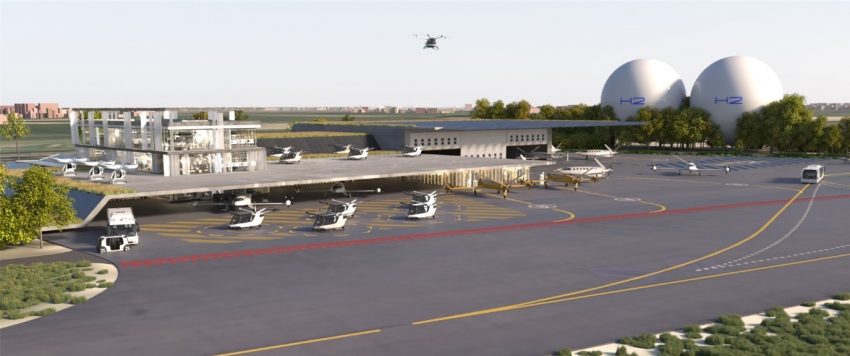The year started off well for sustainable aviation, with a strong surge in hydrogen & SAF development. The Toulouse Declaration, signed on February 4th, marked a new milestone with over 35 European countries and 146 industry stakeholder groups agreeing on the sector’s first public-private plans to achieve decarbonisation goals as set in Destination 2050. Following ambitious target setting in 2021, 2022 is becoming the year in which the sector needs to develop their sustainability plans to achieve 2050 targets.
All eyes on hydrogen
In the short term, Sustainable Aviation Fuel (SAF) is putting the industry on a clear path towards decarbonization, with national and European mandates pushing airlines and also airports to collaborate in the development of SAF supply. In the longer term, hydrogen emerges as a key technology to fully decarbonize aviation. In the past few months, Airbus presented their A380 ZEROe concept aircraft; promising hydrogen aviation start-ups ZeroAvia, Universal Hydrogen and H2Fly are scaling up following large rounds of funding; and UK research group ATI FlyZero as well as the EU-funded Clean Aviation are pushing for more research on hydrogen aviation.
Assuming hydrogen aviation develops at the pace required to achieve Net Zero aviation targets by 2050, a fundamental change in airports’ fuel supply infrastructure and operations is required. Currently, French airports backed by state funding and support for hydrogen (including Toulouse, Lyon & Paris CDG) are leading in the development of hydrogen infrastructure and operations. They do this mainly by providing research for funding, and by looking into opportunities to decarbonize ground support equipment through hydrogen to gain hydrogen safety and operations knowledge. Meanwhile, Hamburg and Stuttgart airports in Germany, Cranfield and Bristol airports in the UK, and RTHA in the Netherlands are also looking into or already developing hydrogen aviation infrastructure.
Hydrogen aviation infrastructure and operations requirements
For airports, the transition will require close partnership with the rest of the aviation sector, a willingness to learn from other sectors that already work with hydrogen infrastructure, and finally a strong investment in hydrogen technology, knowledge development and human resources. Let’s consider four aspects of the integration of hydrogen aviation at airports.
Green hydrogen generation and availability
The availability of green hydrogen, produced through electrolysis with renewable energy is currently very low, and costly. Although supply is expected to increase and prices are expected to drop, this will only happen if there is a clear demand from the aviation sector, including airports. Developing relations with green hydrogen suppliers, including the declaration of MOUs, partnerships, and even shared investment into hydrogen production facilities are all measures airports can take to support the generation and availability of green hydrogen.
Airport supply & refueling concepts
There are multiple possible methods to deliver the hydrogen to the aircraft for refueling. Extensive research by ATI FlyZero describes three pathways, depending on the size of the airport, amount of hydrogen uptake and technology development. The first option is cryogenic hydrogen supply by truck, with on-airport storage. The second option allows for hydrogen delivered by pipeline with the liquefaction and storage done at the airport. The third option requires only the delivery of green electricity, with hydrogen production, liquefaction and storage at the airport. Airport size, volume uptake, and aircraft technology also influence the possible refueling concepts, which can be done through airside refueling trucks, a hydrogen hydrant system, or hydrogen tank swaps.
Space requirements & turnaround time
Hydrogen refueling requires more space, and a longer turnaround time than current jet A1 fuel refueling. Both space and time impacts are heavily dependent on technology development, as well as safety measures. Adapting special hydrogen refueling areas can prepare airports for hydrogen operations. Furthermore, engineers and technical personnel must be educated to handle hydrogen refueling and infrastructure. This is required for hydrogen storage and possible liquefaction and production, as well as for aircraft refueling. Turnaround time changes must be accounted for in the entire airport operations.
Safety & Certification
Hydrogen safety must be prioritized for all airports considering the stringent safety measures within the aviation sector. In collaboration with safety stakeholders such as fire departments and utilities management companies, hydrogen safety knowledge from other industries and sectors must be transferred to the airport environment. Additionally, airports must work together with certification bodies, both on a national and international level, to ensure that safety standards and operations standards become globally accepted and followed.
Developing hydrogen aviation to achieve a sustainable aviation sector will require innovation from all stakeholders. As hydrogen aircraft develop, airports that want to lead in the transition towards sustainability must take their responsibility to develop the necessary infrastructure and operations. Only by working together can the aviation sector decarbonize. At To70 we have developed knowledge and experience regarding sustainable aviation infrastructure and continue to support airports and all other stakeholders in this transition. To find out more, get in touch with Vincent de Haes.

